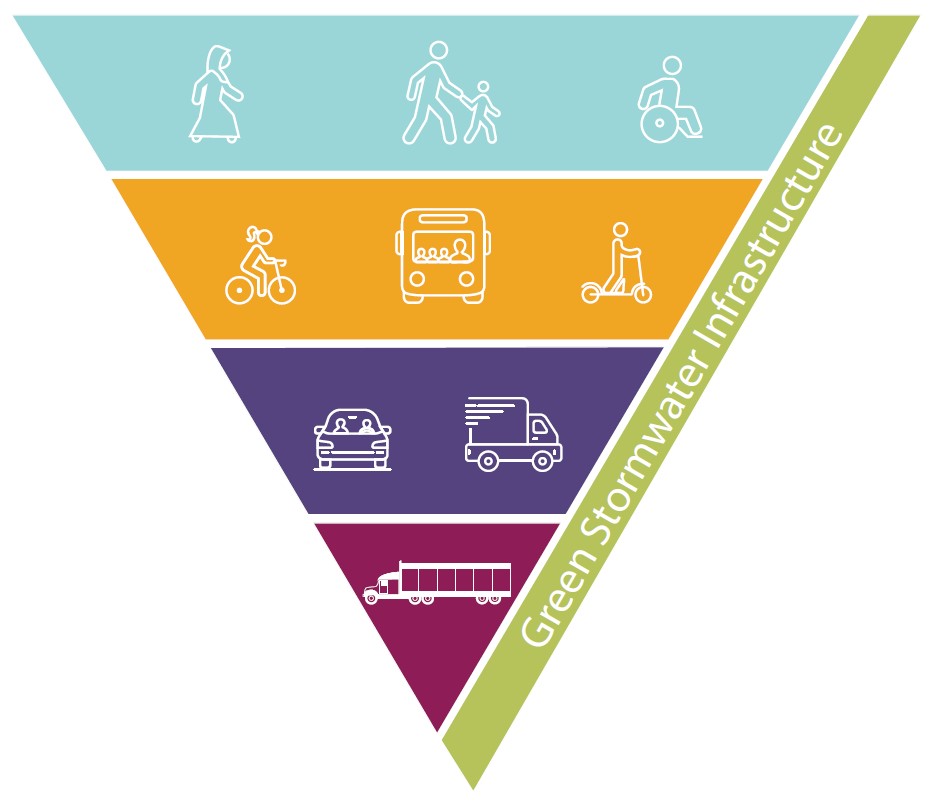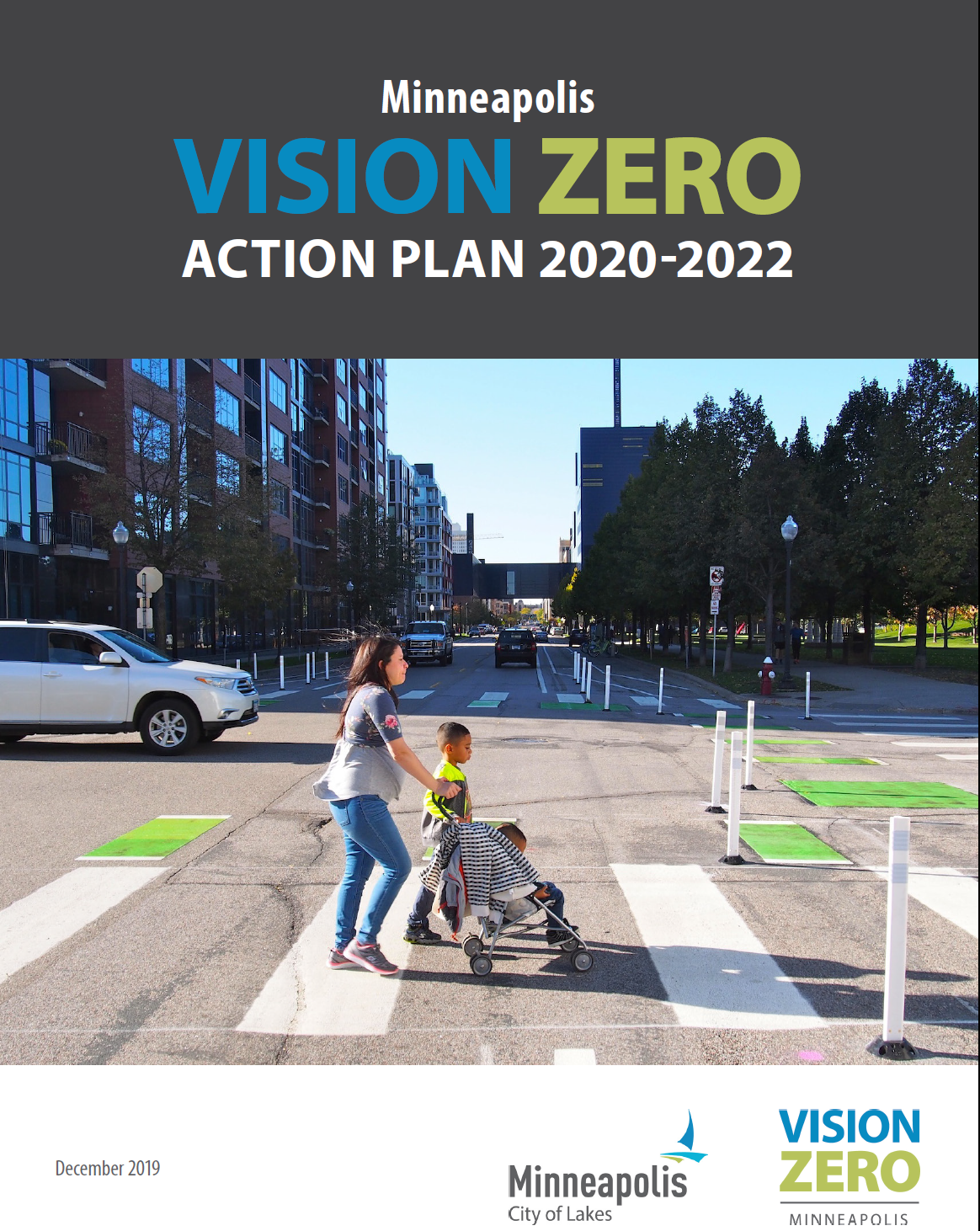1.2 Policy Guidance
Search Content
Download PDF
Print Guide
The Transportation Action Plan provides the most direct guiding policy for the Street Design Guide, which includes the strategy to develop this guide.
The Street Design Guide will recognize streets as the city’s largest public space and institutionalize the City’s Transportation Action Plan, Complete Streets Policy, Vision Zero commitment, greenhouse gas emission reduction goal, commitment to racial equity, and stormwater management requirements through the design of the right of way.
The City of Minneapolis has strong policies that direct resources and set priorities relative to transportation. Key policies include:
Complete Streets, which establishes a modal priority framework that prioritizes people as they walk, roll, bicycle, and take transit over driving, deliveries, and parking;
Vision Zero, which sets a goal of ending traffic related fatalities and life-changing injuries on our streets by 2027;
Climate-related goal to reduce citywide greenhouse gas emissions by 30% by 2025 and 80% by 2050 (from 2006 emissions levels), including goals to reduce transportation sector greenhouse gas emissions by more than 30% by 2030 (from 2018 levels);
Goal of having 60% of trips taken by means other than a car by 2030 (walking, biking/micromobility, or taking transit);
Commitment to racial justice, detailed in the City's Strategic Racial Equity Action Plan, which seeks to dismantle institutional injustice and close racial disparities in health, housing, public safety and economic opportunities; and
The Racial Equity Framework for Transportation, which outlines strategies and actions to eliminate racial disparities in transportation through transportation plans, programs, and projects; and
Stormwater management programs that increase pervious areas and incorporate stormwater best management practices into linear projects to improve the water quality in the city’s lakes, creeks, and the Mississippi River.
These policies give clear direction for an approach to how we design our streets. Street design must reflect these policies and translate them into opportunities for increased health and safety outcomes for everyone and improved walking, biking, transit, and green infrastructure.
- Transportation Action Plan
- Minneapolis 2040 plan
- Accessibility regulations and guidance
- Complete Streets policy
- Vision Zero policy and Vision Zero Action Plan
- Strategic and Racial Equity Plan
- Racial Equity Framework for Transportation
- Stormwater management requirements
Transportation Action Plan
The Minneapolis Transportation Action Plan is a 10-year action plan to guide future planning, design and implementation of transportation projects for all people in all the ways they move around. It was adopted by the City Council in December 2020. The Transportation Action Plan provides the most direct guiding policy for the Street Design Guide and is shaped by other important City policies such as Minneapolis 2040, the Climate Action Plan, Vision Zero, and Complete Streets.
The Transportation Action Plan seeks to unlock the potential of our streets as places for people and as an invaluable asset for broader outcomes achieved by making investments in our transportation network that work toward City goals.
The plan includes this general vision for streets:
In 2030 our streets will reflect our City values. Our streets will be designed to address a climate emergency by emphasizing low or no carbon travel. Our streets will correct historic injustices in our transportation systems, because focusing on climate justice is focusing on racial justice. Our streets will add protection for people walking and bicycling and will be designed to prioritize an effective transit system that serves all trips. Our streets will be organized to enhance access to jobs. Though our streets will continue to serve car traffic, our future depends on our ability to increase the city’s population as projected in Minneapolis 2040 without the car traffic associated with growth. This plan does not eliminate places for people to drive, it simply rebalances space to incentivize and allow for low carbon transportation options.
The Transportation Action Plan includes six goals that help guide transportation decisions by the City through 2030: climate, prosperity, safety, mobility, equity, and active partnerships (see Figure 1.2B).
The Transportation Action Plan includes a Design for People topic with strategies and actions to support the plan’s six goals.
Figure 1.2B:
Transportation Action plan goals

Minneapolis 2040 plan
Minneapolis 2040 is the City’s Comprehensive Plan that shapes how the city will grow and change. The plan covers topics such as housing, job access, the design of new buildings, and how we use our streets. It was adopted by the City Council in December 2018.
The Transportation Action Plan is aligned with Minneapolis 2040 and provides additional transportation-focused detail to the vision, goals, and policies in Minneapolis 2040 (see Figure 1.2C).
The Street Types in this guide support the planned land uses and built form in Minneapolis 2040 and this guide in consistent with Minneapolis 2040.
Figure 1.2C:
Minneapolis 2040 transportation related themes

Accessibility regulations and guidance
Enacted in 1990, the Americans with Disabilities Act (ADA) prohibits discrimination on the basis of disability and mandates equal opportunity for individuals with disabilities. Title II of the ADA and Section 504 of the Rehabilitation Act of 1973 require state and local governments to provide pedestrian access for people with disabilities whenever a pedestrian facility exists in order for people with disabilities to equally access and benefit from an agency’s programs, services and activities.
Private development projects, private and public utilities, contractors, and public agencies that impact the public right of way are required to maintain accessibility throughout construction activities and restore sidewalk, pedestrian curb ramps, street crossings, and traffic signal infrastructure and any other City-owned infrastructure so that the infrastructure complies with current ADA and City standards and functions as a complete system.
ADA compliance includes reconstruction of public sidewalks to at least the minimum dimensions established for the pedestrian accessible route (PAR, which is included as part of the pedestrian clear zone in the sidewalk standards of this guide), the reconstruction of impacted pedestrian ramps to current ADA standards, and the installation of Accessible Pedestrian Signal (APS) systems. Public Works often requires developers and designers to construct public sidewalks with widths beyond minimum ADA requirements to align with other goals and this guide. Developers, designers, and others working within the public right of way should refer to this Street Design Guide, ADA Transition Plan for Public Works, Standard Supplemental Specifications for Construction of Public Infrastructure, and the following federal regulations for current standards and guidance.
Governing ADA Regulations and Guidance
The most recent ADA standard is the 2010 ADA Standards for Accessible Design, which sets the minimum requirements – both scoping and technical – for newly designed and constructed or altered State and local government facilities, public accommodations, and commercial facilities to be readily accessible to and usable by individuals with disabilities. It is effectuated from 28 CFR 35.151 and the 2004 Americans with Disabilities Act Accessibility Guidelines (ADAAG). The Federal Highway Administration (FHWA) and Department of Justice (DOJ) are in process of finalizing rulemaking to make standard the Accessibility Guidelines for Pedestrian Facilities in the Public Right of way (PROWAG). Standards in the Manual on Uniform Traffic Control Devices (MUTCD) are also incorporated within PROWAG.
The City of Minneapolis follows the most recent 2010 ADA Standards for Accessible Design and looks to the 2023 Guidelines for Pedestrian Facilities in the Public Right of way (PROWAG) for guidance on how to supplement the 2010 ADA Standards. The Minneapolis Street Design Guide incorporates current standards and best practices, and seeks to establish guidance for designing and constructing projects in the public right of way in Minneapolis that exceed these standards and best practices. Further construction and design requirements for building public ADA infrastructure in the right of way can be found in the ADA Curb Ramp Design, Construction and Repair Technical Memorandum.
ADA Transition Planning in the City of Minneapolis
The ADA Action Plan is the City’s comprehensive policy document that addresses citywide programs and services and fulfills the Title II legal requirements for local governments. The ADA Action Plan is supplemented by the ADA Transition Plan for Public Works, which addresses Title II requirements and accessibility needs within the City of Minneapolis’ public right of way.
Complete Streets policy
The Minneapolis Complete Streets policy establishes a modal priority framework that prioritizes people as they walk, roll, bicycle, and take transit over driving, deliveries, and parking (see Figure 1.2D). The policy was adopted by the City Council in 2016 and updated in 2021.
The Street Design Guide follows the Complete Streets policy. Both the Complete Streets policy and Street Design Guide recognize that the process for designing individual streets will be based upon project-specific objectives and context sensitive design solutions supported by the modal priority, street type and place types, documented modal needs, multimodal metrics, issues, opportunities, functionality, environmental or social factors, right of way impacts, and input from stakeholders and the community.
Figure 1.2D:
Complete Streets graphic

Vision Zero policy
Vision Zero is the City’s commitment to eliminate traffic deaths and severe injuries on City streets by 2027. The City Council adopted the Vision Zero resolution in 2017 and adopted the 2023-2025 Vision Zero Action Plan in 2023.
The loss of human life in traffic deaths on our streets is unacceptable. The City is committed to ending death and life-altering injuries on our streets. We will work with urgency to implement Vision Zero as one death on our streets is one too many.
Vision Zero takes a systematic approach to traffic safety that coordinates efforts across engineering, public safety, health, and community outreach and uses the best available data. Vision Zero recognizes that humans will make mistakes, but that we need to design safe systems so that individual mistakes do not lead to death or severe injuries.

Racial Equity Framework for Transportation
Adopted in 2023, the Racial Equity Framework for Transportation (REF) outlines the racial disparities in transportation currently experienced by Minneapolis residents, the historical causes of inequity, and the City's responsibility in reversing those outcomes. It sets goals in achieving an equitable transportation system and establishes a set of strategies and actions to be used to reach those goals.
One of these goals is that the City's transportation efforts should "Lead with a Racial Equity Approach." To achieve this goal, the REF directs the design of city streets to be undertaken with a primary consideration of racial equity:
Apply the REF to decisions made about how we design, operate, and maintain our streets.
Tie historic and current inequities in our transportation system to decision-making around how we design, operate, and maintain our streets.
It also directs street design processes to consider the costs associated with car ownership and design for more affordable options such as walking, biking, and transit:
Recognize transportation as an integral tool for people's economic stability.
Correlate the cost of transportation and car ownership rates with design decisions and project justification.
Stormwater management requirements
Surface water resources, parks, and open spaces are distinctive features of the City of Minneapolis and part of its identity. The City takes a proactive approach to managing its water resources and infrastructure, recognizing that the health and vitality of the lakes and urban streams are linked to how property and storm and sanitary sewer systems are managed.
City, watershed, and state regulations guide management of stormwater runoff to protect water quality and mitigate flooding concerns. The Street Design Guide works to add additional pervious surface and green stormwater infrastructure to reduce harmful runoff and flooding, to meet water quality goals, and to mitigate the stress of impervious surfaces on the stormwater system. Increasing green infrastructure also provides additional benefits that align with the City’s goals for climate, safety, equity, and Complete Streets.
Starting in 2022, if a project disturbs over ½ of an acre, it is subject to the Stormwater Ordinance: Minneapolis Ordinance Chapter 54 – Storm Water Management.


